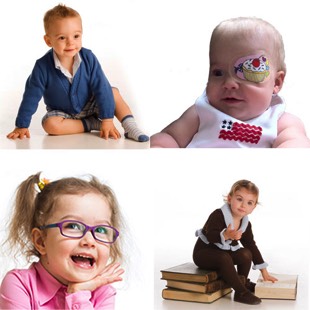
Preschoolers
Between ages one and two, it’s important for a child to develop good hand-eye coordination and depth perception.
There are activities that can help improve these essential visual skills, such as playing with building blocks or balls of any shape and size.
Children at age two enjoy listening to and looking at storybooks. It helps them develop visualization skills and prepares them for learning to read. At this stage of their development, toddlers also like to paint, draw and colour, sort shapes and sizes, and fit or assemble pieces. These activities are all integral to their visual development.
A preschooler’s eyes are not ready for prolonged or intense concentration at short distances, but they do enjoy TV. To make TV viewing easier on the eyes, the room should be softly lit, the television placed to avoid glare, and the child should sit further away than five times the screen’s width, taking periodic breaks from staring at the screen.
Be alert for symptoms that may indicate your child has a visual problem:
- red, itchy or watering eyes
- sensitivity to light
- an eye that consistently turns in or out
- squinting, rubbing the eyes, or excessive blinking
- a lack of concentration
- covering or closing one eye
- irritability or short attention span
- holding objects too close
- avoiding books and television
- visible frustration or grimacing

School-age children
A school-age child’s eyes are constantly in use in the classroom and at play. For school-age children, several different visual skills must work together so they can see and understand clearly.
If any of these visual skills are lacking or impaired, your child will need to work harder and may develop headaches or fatigue. Often the increased visual demands of schoolwork can make greater demands on a child’s visual skills, pointing out a vision problem that was not apparent before school. The child may not realize they have a vision problem – they may simply assume everyone sees the way they do. A vision-related problem may cause some of the symptoms described below:
- headaches or irritability
- avoidance of near or distance work
- covering or rubbing of the eyes
- tilting of the head or unusual posture
- using a finger to maintain place while reading
- losing place while reading
- omitting or confusing words when reading
- performing below their potential
Conditions that may emerge during this stage in your child’s life include myopia or nearsightedness (blurred vision when seeing objects at a distance), hyperopia or farsightedness (blurred vision when seeing objects up close) and astigmatism (distorted vision at all distances).
Protect your child’s vision. If you notice any of these symptoms, book an eye exam with a Doctor of Optometry. Your child should have a complete optometric eye exam at six months, before starting kindergarten, and annually throughout the school years to ensure optimal eye health and developmental progress.

Adults
For adults, a regular eye exam is an important part of maintaining your overall health and making your vision last a lifetime. Without an eye exam, critical health issues can be overlooked until it’s too late.
Our eyes change as we age. In particular, people over the age of 40 may be at an increased risk for age-related eye conditions, some of which may have no visible symptoms until the condition is advanced and difficult, or even impossible, to treat.
The most common eye problems among adults include:
- Presbyopia: a natural effect of aging in which the ability to focus on close objects decreases over time. Presbyopia can cause headaches, blurred vision, and the need for more light or sore eyes.
- Cataracts: distorted or cloudy vision caused by the lens inside the eye losing its transparency over time. Cataracts can require changes to your glasses or surgical removal.
- Diabetic Retinopathy: a weakening or swelling of the tiny blood vessels in the retina of your eye, and the growth of new blood vessels resulting in blood leakage and other changes. If left untreated, blindness can result.
- Macular degeneration: a disease that results in degenerative changes to your central vision, and is a leading cause of vision loss among older adults.
- Glaucoma: a “silent thief” that often has no symptoms until significant damage has occurred. Glaucoma is caused by elevated pressure within the eye, and can lead to serious vision loss if not detected and treated at an early stage.
Your eyes are also windows to your overall health, and an eye exam can also uncover underlying—and life-threatening—health issues, such as Type 2 diabetes, brain tumors, cancer of the eye, high blood pressure, certain vascular diseases and brain or eye tumors.
Adults aged 19 to 64 should have an eye exam at least every two years, and people with diabetes should have an exam at least once a year. Other health conditions assessed by your Doctor of Optometry may also warrant more frequent eye examinations.




